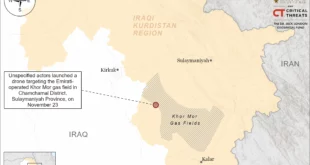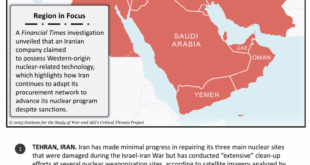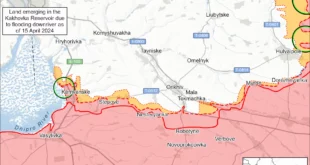U.S. officials are increasingly confident they have deterred Iran-backed militias in Iraq and Syria, which have not attacked U.S. forces for more than one month.
U.S.-Iraq talks to limit or potentially end a U.S. military presence in Iraq appear to have contributed to the decision by pro-Iranian groups to halt their attacks.
The same strategies that deterred Iraqi and Syrian militias might not cause the Houthi movement in Yemen to cease its attacks on shipping in the Red Sea.
Pro-Iranian groups in Iraq and Syria are more susceptible to Iranian as well as domestic pressure than are the Houthis.
Since the October 7 Hamas attack on Israel, U.S. officials have struggled to prevent the Gaza war from expanding, but they have had mixed success deterring attacks by Tehran-supported regional armed factions. The stated intent of attacks by pro-Iranian groups on Israel, U.S. forces in the region, and commercial shipping in the Red Sea is to bring about a halt to the Israel Defense Forces (IDF) offensive to dismantle Hamas’ rule and military infrastructure in the Gaza Strip. Although couching their actions as support for Hamas, regional Iran-backed groups in Iraq and Syria are also trying to advance a variety of objectives that long predate October 7. Iran and the Iraqi militias it arms and funds have sought for more than five years to force the approximately 2,500 U.S. military personnel, serving in the global mission to defeat the Islamic State (IS), to leave Iraq. More broadly, it has been a consistent goal of Iranian leaders to push U.S. forces out of any country bordering Iran and out of the Persian Gulf region entirely. Iran’s regional allies also constitute the key pillar of Iranian strategy to pressure Israel on all its borders and eventually render it non-viable.
U.S. planners have sought to retaliate for Iran-backed attacks gradually, in the hopes of achieving deterrence and de-escalation. From October 19 until February 3, Iran-supported militias in Iraq and Syria, particularly the Iraq-based Kata’ib Hezbollah (KH) and Harakat Hezbollah al-Nujaba (Nujaba Movement), conducted more than 180 attacks on bases in Iraq and Syria where U.S. anti-IS forces were deployed. The Iraqi groups operate not only in Iraq, but also in Syria, where they support the regime of Bashar Al Assad, in conjunction with Syrians and South Asian Shia fighters recruited by Iran. Until February, U.S. retaliatory attacks on armed groups in both Iraq and Syria were infrequent and relatively limited. However, a militia strike on a U.S. base (Tower 22) on the Jordanian side of the border between both Iraq and Syria prompted a significant U.S. escalation. On February 3, U.S. warplanes, including B1-B bombers flying from the continental United States, struck 85 militia targets across seven locations in Iraq and Syria. Four days later, a U.S. armed drone conducted a precision strike on a KH logistics commander involved in the Tower 22 attack, striking only his car and causing no civilian casualties. The two strike packages represented a demonstration of U.S. intent and technological prowess, causing KH, reportedly at the behest of Iran, to announce a halt to its attacks on U.S. bases. Defense Department spokespersons say the Iraqi and Syrian militias have conducted no attacks since, but officials have stopped short of predicting that militia assaults would not resume.
U.S. and Western officials and strategists hope to apply some of the lessons learned from the effort to deter Iraqi and Syrian militias to the Houthi movement in Yemen. The Houthis have thus far been impervious to progressively escalating U.S. strikes on their missile and armed drone arsenal. The Houthis have also defied U.S. and allied expectations that a campaign of airstrikes would thoroughly degrade what was thought to be a limited arsenal. Yet, the mitigating factors that led the Iraqi and Syrian militias to stand down might not apply to the Houthis. The U.S. agreement to convene talks with the Iraqi government on a possible drawdown of the U.S. military presence was an underweighted factor in persuading the Iraqi and Syrian militias to relent. On January 24, as Iran-backed attacks in Iraq and Syria – and U.S. retaliatory attacks inside Iraq – were escalating, the United States announced the start of talks with Iraqi officials on a timeline for reducing the U.S. military presence. U.S. strikes in Iraq had prompted Iraqi Prime Minister Mohammad Shia al-Sudani, an ally of powerful pro-Iranian Shia groups but also an advocate for the U.S. military advisory mission, to accuse the United States of violating Iraqi sovereignty. The convening of the U.S.-Iraq talks has enabled Sudani to argue that Iran-backed Iraqi groups might achieve their paramount goal (expelling U.S. forces) through diplomacy and that continued attacks on U.S. forces in Iraq and Syria might delay, rather than hasten, a U.S. drawdown. The United States and its partners have similarly continued pre-existing diplomacy to end the civil conflict in Yemen, but the differences between the Houthis and their Gulf state-backed Yemeni adversaries have widened, not narrowed, since the October 7 Hamas attack. The Houthis do not see diplomacy as accommodating their demands for an end to the war in Gaza, or for complete control over a post-war government in Yemen.
Beyond diplomacy, a number of factors apply to the Iraqi and Syrian militia factions that do not affect the Houthis. First and foremost, Iranian leaders have far more influence over the Iraqi and Syrian militias than they do over the Houthis. Iran’s Islamic Revolutionary Guard Corps (IRGC) largely created most of the Shia factions that have been attacking U.S. bases, and it similarly recruited Syrian fighters to help Syrian President Bashar Al Assad defeat an armed rebellion that erupted in 2011. Following the February 3 U.S. retaliatory attack in Iraq and Syria, IRGC-Qods Force commander Esmail Qaani reportedly instructed KH, Nujaba, and other pro-Iranian armed factions in Iraq and Syria to halt further attacks on U.S. forces, at least temporarily. Iranian leaders, careful to avoid provoking U.S. military action against Iran itself, apparently assessed that the killing of the three U.S. servicepersons in Jordan was emboldening those in Washington advocating major escalation, including direct U.S. action against Iran. By contrast, the Houthis Arab Spring-related rebellion in Yemen succeeded in capturing the capital, Sanaa, in 2014 without Iranian support. Iran began supplying the Houthis with more sophisticated weaponry only after they wrested control of much of Yemen and had begun to do battle with the Saudi Arabia-led Arab coalition that intervened in 2015 to try to push the Houthis back. In addition, the Houthis belong to the Zaidi sect (Sevener) of Shia Islam and do not follow the same Shia ideology as that practiced by Iran and its leaders (Twelver Shiism). Still, if a Houthi attack were to cause mass U.S. casualties, it is possible Tehran might try to exercise all available leverage to compel the Houthis to announce a halt to their attack campaign or, at the very least, ensure that any U.S. retaliation is conducted against the Houthis, and not against Iran itself.
Moreover, Iraqi and Syrian militia groups are under far more domestic constraints than the Houthis in Yemen. In Iraq, other major factions, including the large Shia movement of cleric Moqtada Al Sadr, have sought to prevent pro-Iranian leaders from dominating key institutions, including the elected National Assembly. In Syria, the Assad regime has ensured that Iran and Iran-recruited factions cannot compete for power with his Alawite community-dominated inner circle. The Houthis, by contrast, have largely defeated forces of the ousted Republic of Yemen Government, and Saudi Arabia and its key ally, the United Arab Emirates, have shown no inclination to restart ground combat operations against the Houthis. However, the longer the Houthi threat to global commerce through the Red Sea persists, the more likely U.S. officials to conclude that major military escalation was key to quieting Iraqi and Syrian militia attacks and try to apply a similar strategy to the Houthis.
 Eurasia Press & News
Eurasia Press & News



